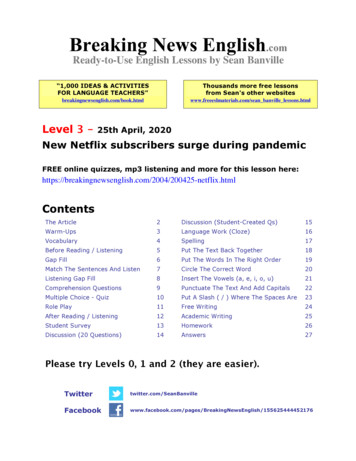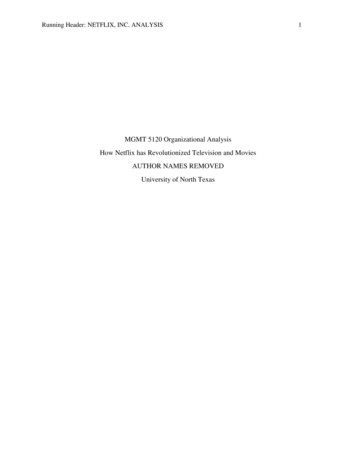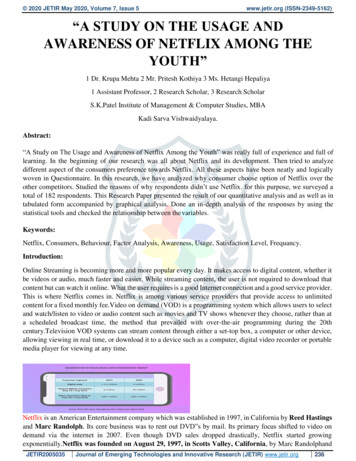
Transcription
Netflix: Financial PositionAnalysis and Evolution in theMarket for Online StreamingServicesDepartment of Economics and BusinessChair of Introduction to Business EconomicsSUPERVISORCANDIDATEProf. Saverio BozzolanPierfrancesco Mazzolini174501ACADEMIC YEAR 2015/20161
“Do not follow where the path maylead. Go instead where there is nopath and leave a trail.”Muriel Strode2
Table of ContentsIntroduction . 4Chapter One: Netflix Company Description . 61.1 Netflix Brief History . 61.2 A look into a new market: Over-the-top services . 91.3 Biggest step into success: The passage to original content . 111.4 The future of Netflix . 121.5 Netflix in Italy . 14Chapter Two: Netflix’s Financial Analysis . 162.1 Liquidity . 162.2 Financial Strength . 182.3 Profitability . 202.3.1 Return on Investments . 202.3.2 Return on Sales . 232.4 Short-term operating Activities . 262.5 Long-term Investments . 27Chapter Three: Netflix vs. Competition . 293.1 Brief description on Amazon’s Business Strategies . 303.2 Amazon Prime Instant Video . 313.3 Financial Aspects . 323.3.1 Liquidity . 333.3.2 Profitability . 343.3.3 Earnings Per Share (EPS) . 363.3.4 Efficiency . 363.3.5 Short-term Operating Activities. 363.3.6 Long-term Investments . 37Conclusion . 39Bibliography . 413
IntroductionThroughout the beginning of the 21st century, as our world was experiencing a strong evolution intechnology, new consumer trends were starting to expand in the broadcasting industry. Coming froman era were services in the television sector were very broad and limited, the latest implementation ofonline streaming services, has since permitted customers to benefit from a wide range of availablecommodities. As the television industry faces new innovations, industry incumbents encounter newchallenges, and already established competitors are displaced. In consequence, the online videostreaming service is considered a disruptive innovation to the conventional TV system.Several enterprises however, have been able to distinct themselves for their capacity to react tomarket changes and to the transformations caused by the many innovations introduced at the time.Netflix presents a consolidated example of this firms who have been able to positively react to themarket alterations. This company has encountered several structural modifications in order to adapt tothe possibilities that the “new” market had to offer. Netflix was originally created as an online DVDrental service, for then successfully establishing itself in the market for over-the-top (OTT) services.The company’s successful incorporation in the market and the growing popularity of the service haspermitted Netflix to realize its own original products. Some popular examples of Netflix’s originalsare the TV-shows House of Cards, Narcos, and Orange is the new black.The purpose of this thesis is to investigate, from a business and financial point of view, the progressthat the online television industry has had in the last decade. Specifically, the main focus of this paperwill be emphasized on Netflix, which in the last few years has been the leader in this specific sector.The company has successfully entered the television industry by combining complementarytechnologies, reinventing the home video rental model, and by undertaking costumer needs. Bycentralizing Netflix as the core of the discussion, the thesis will identify the evolution of a specificbusiness in the market, and the dynamics of a disruptive innovation. All this will be backed up byboth quantitative (empirical) and qualitative data, showing a balance sheet analysis of the companyduring the last three years. The thesis will also include primary sources from newspapers and journalarticles discussing the structure of the company, and first hand empirical data taken by the company’swebsite. The dissertation will also present a deeper intuition (from a financial point of view) of thecompany, comparing the financial position of Netflix with its main competitors, specifically Amazon(Amazon Prime Video).4
Overall, the thesis will be divided into three different chapters. The first chapter will expose thehistory of Netflix, and will analyze the business model of the company taking into consideration threemain questions: What are Netflix’s reasons for success? In what does Netflix differ from itscompetitors? And finally, what opportunities can the company seek to improve in the future? Thesecond chapter will cover a financial analysis of the company. It will show a balance sheet andfinancial statement analysis, evaluating the well-established financial position of the company duringthe last several years. The third chapter will evaluate an analogous financial analysis of one ofNetflix’s main competitor Amazon, with its latest service Amazon instant video. With the finalresults and data at hand, the chapter will conclude with a comparison between both companiesevolution in the market during the last three years. In the conclusion, the thesis summarizes all theinfluencing factors, which played an important role in the evolution of Netflix in the market of onlinestreaming TV. It will also be discussed the disruptive nature of the company, and an ex-posthypothesis will be given on how the company can improve, and on the characteristics which permitconsumers to foresee Netflix as an important service that will satisfy their expectations for manymore years.5
Chapter 1: Company description1.1 Netflix HistoryReed Hastings, Mark Randolph and Mitch Lowe founded Netflix in 1997 as a movie-rental service,and as an answer to the inconvenient problems of movie rentals late fees1. The initial idea came toHastings when receiving a 40 fine for returning an overdue copy of the movie Apollo 13. The basicidea behind Netflix was that of creating a movie-by mail-rental service that would benefit from thenew context that was born with the development of the Internet. Clients could choose which DVD’sto rent within the company’s online platform from which they had previously subscribed. Theplatform, which was officially launched in April 1998, allowed customers to access a vast filmcatalogue, divided into sections by genre, actors, or producers. The chosen DVD’s where then sentvia mail directly to the clients house the day after they where being selected. The number of DVD’savailable for renting where determined by type of subscription. The subscriptions had severalvariations, but the main one was the one with a cost of 19,95/month, which permitted users to rentup to 3 DVD’s at a time.At the time (beginning of 21st Century) the market for movie renting wasn’t very vast, in fact thecompany could benefit from a rapid success due to little competition between businesses thatrendered the service. Hastings stated, “We were targeting people who just bought DVD players. Atthe time our goal was just to get our coupon in the box. We didn’t have too much competition. Themarket was underserved, and stores didn’t carry wide selection of DVDs at the time”2. In fact in notime, the idea of focalizing on the market of DVDs was revealed to be the right strategic road to take.DVD players became the most adopted technology at the time. In the US throughout the 1990s, thepresence of DVD players in houses was used by approximately 5% of the population. Within oneyear time (beginning of year 2000) this number increased to 13%, to finally increase to 37% users in2002.3 The following chart (Fig.1) shows the periodic increase in Netflix’s subscriptions from theyear 1999 to 2003.1Legend has it that Hastings found an old, forgotten rental copy of Apollo 13 in his closet that had accumulatedsomewhere in the neighborhood of 40 or 50 in fees.2Willy Shih, Stephen Kaufman, and David Spinola, ―Netflix,ǁ HBS No. 9-607-138 (Boston: Harvard Business SchoolPublishing, 2009), 0/20030620-113258-1104r/6
Figure1: Netflix subscriptions growth. Source: Business 2.0 “How Netflix is Fixing Hollywood”Netflix’s strategic turning point and main strength was that of having customer’s enjoying DVD’s intheir homes at all times and most importantly without having to pay late fees. However, this didn’timply that customers could keep the DVD’s; as a matter of fact Netflix’s strategy pushed them toreturn anyway the items used. This because the platform gave the users the possibility to access“renting slots” in their profile, based on the type of subscriptions they had. The more they paid forthe subscriptions, the more available slots they had for renting DVDs. The slots in fact remainedoccupied until the client returned the DVD they had previously rented.Netflix’s main competitor in the DVD rental market was Blockbuster. For several years, whileNetflix acquired more and more subscribers, Blockbuster didn’t introduce any opposing strategy tocontrast its main competitor. “Netflix has transcended the traditional model’s rental time constraints,demonstrating a more complete understanding of customer use needs”4. One of the most importantdates in Netflix’s history was the day of the first initial public offer (IPO) on March 23, 2002. It wasonly then that Blockbuster started to act in opposition of its competitor. They first started in 2003 byintroducing an in-store subscription pass with unlimited renting availability and without a late fee5.Later in 2004, the company announced its online subscription service (Blockbuster online), which4Stefan Michel, Stephen W. Brown, Andrew S. Gallan, Service-Logic innovations: How to Innovate Customers, NotProducts, in California Management Review», L, 2008, 3, /93/Blockbuster-Inc.html7
delivered DVD’s to the customer’s home without shipping charges6. The newborn service at firsthelped blockbuster to obtain a reasonable amount of clients, but maintenance and transaction costsfor the service were considered too massif to maintain. In fact in little time they saw themselvesforced to abolish the “no late fee” policy that had previously attracted more subscribers. It wasestimated that the costs for the service were of about 400 million dollars7. Apart from Netflix andBlockbuster, the market for DVDs in the US was also dominated by a third firm: Wal-Mart. WalMart was specialized in the retailing from the big chain of stores from which was in possession. Itwas the first company to acknowledge that the market for DVDs had potential; in fact they offered asimilar service as Netflix (with DVDs sent by mail and no late fees) but with lower costs. HoweverWal-Mart didn’t present a big threat for Netflix, since Hasting’s company could benefit from a muchlarger variety of DVDs and of bigger storages. An important turning point, which additionallyfostered Netflix’s position in the DVD renting market, was when they entered an agreement withWal-Mart in 2005, which consisted in joint promotional activities for movie sales and rentals, whichproposed to its own customers and subscribers to join the Netflix service.8 Following this agreement,the only true competitor remained in the market was Blockbuster.One of Netflix’s key aspects for its success in the online-DVD-renting sector was thecentralization of costumers needs as the core of its business model. To get in acquaintance with whatsubscribers had to suggest to improve the companies key features, Netflix created the so-calledNetflix Prize. The Netflix Prize was a million dollar award granted by the company to anyone whosought to improve the accuracy of predictions about how much someone is going to enjoy a moviebased on their movie preferences9. To this end, Netflix conceded almost one hundred millionvaluations of 18,000 securities for 480,000 clients. The Netflix Prize attracted almost 18,000subscribers from 150 different companies and was won in 2009 by the team Belkor’s PragmaticCaos10. The team composed by AT&T research engineers won the price by formulating the best wayto improve the company’s movie recommendation algorithm, which generates an average of 30billion predictions per day, by 10 percent or more11. Thanks to improvement provided for the service,Netflix finally sought the chance to outweigh Blockbuster as primary competitor for the market. Therivalry with Blockbuster ended with the bankruptcy of the firm in 2013.6IbidemCfr. Jeanine Poggi, “Blockbuster's Rise and Fall: The Long, Rewinding Road”, ding-road.html8http://www.marketline.com, reference code: 0F65E223-CCF4-4CBF-A37F-BA7C747C2040, ze/78
1.2: A look into a new market: Over-the-top servicesNetflix’s objective was always the one of exploiting the Internet in order to rend the company ascompetitive as possible. With the periodic increase in the number of subscribers and with the defeatof the rival Blockbuster, a modification of the system seemed to be the best way to keep the companyup to date with the continuous advances in technology. In those years there was a new market, whichwas attracting the attention of big companies such as Netflix. This new market was based on a newonline-television content distribution system, the Over-the-top service (OTT). The term Overt-the-toprefers to services, which are available over a network, but are separate from those of what yournetwork providers offers. It’s referred to as “over-the top” because these services ride on top of theservice you already get and don’t require any business or technology affiliations with your networkoperator12. Thanks to the transmission agreements, the
Netflix's main competitor in the DVD rental market was Blockbuster. For several years, while Netflix acquired more and more subscribers, Blockbuster didn't introduce any opposing strategy to contrast its main competitor. "Netflix has transcended the traditional model's rental time constraints,










